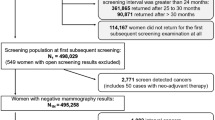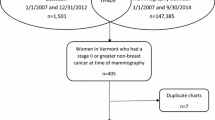Abstract
Previous studies on the association between mammography screening and stage at breast cancer (BC) diagnosis have limitations because they did not analyze persistence with mammography screening and did not distinguish screening from diagnostic mammograms. The objective of this study is to determine the association between persistence with mammography screening and stage at BC diagnosis among elderly women. A retrospective observational study of 39,006 women age ≥70 diagnosed with incident BC from 2005 to 2009 from the Surveillance, Epidemiology, and End Results (SEER)-Medicare dataset was conducted. A validated algorithm with high sensitivity and specificity was used to distinguish between screening and diagnostic mammograms. Persistence with mammography screening was measured as having at least three screening mammograms in five years before BC diagnosis. Multinomial logistic regressions were performed to analyze the association between persistence with mammography screening and stage at diagnosis, in a multivariate framework. Overall, 46 % of elderly women were persistent with mammography screening, 26 % were not persistent, and 28 % did not have any screening mammogram in five years before BC diagnosis. As compared to women who were not persistent with mammography screening, women who were persistent with mammography screening were significantly more likely to be diagnosed at earlier stages of BC. The adjusted odds ratios were 3.28, 2.37, and 1.60 for in situ, local, and regional stages, respectively. A lower proportion of elderly women was persistent with mammography and it was highly associated with earlier stages of BC diagnosis. Interventions designed to promote persistent mammography screening among elderly women are warranted.

Similar content being viewed by others
Abbreviations
- BC:
-
Breast cancer
- US:
-
United States
- SEER:
-
Surveillance, epidemiology, and end results
- FFS:
-
Fee-for-service
- ARF:
-
Area resource file
- ICD-9:
-
International classification of diseases 9th edition
- PCP:
-
Primary care physicians
- AOR:
-
Adjusted odds ratio
- CI:
-
Confidence interval
References
Howlader N, Noone A, Krapcho M, et al (2012) SEER cancer statistics review, 1975–2009 (Vintage 2009 Populations), National Cancer Institute. Bethesda, MD. Based on November 2011 SEER data submission http://seer.cancer.gov/csr/1975_2009_pops09/. Accessed 15 Aug 2014
Hillner BE, Penberthy L, Desch CE, McDonald MK, Smith TJ, Retchin SM (1996) Variation in staging and treatment of local and regional breast cancer in the elderly. Breast Cancer Res Treat 40(1):75–86
Fletcher SW, Elmore JG (2003) Clinical practice. Mammographic screening for breast cancer. N Engl J Med 348(17):1672–1680
Nystrom L, Andersson I, Bjurstam N, Frisell J, Nordenskjold B, Rutqvist LE (2002) Long-term effects of mammography screening: updated overview of the Swedish randomised trials. Lancet 359(9310):909–919
Smith-Bindman R, Kerlikowske K, Gebretsadik T, Newman J (2000) Is screening mammography effective in elderly women? Am J Med 108(2):112–119
Tabar L, Dean PB (2003) Mammography and breast cancer: the new era. Int J Gynaecol Obstet 82(3):319–326
Hellquist BN, Duffy SW, Abdsaleh S, Bjorneld L, Bordas P, Tabar L et al (2011) Effectiveness of population-based service screening with mammography for women ages 40–49 years: evaluation of the Swedish mammography screening in young women (SCRY) cohort. Cancer 117(4):714–722
Walter LC, Covinsky KE (2001) Cancer screening in elderly patients: a framework for individualized decision making. JAMA 285(21):2750–2756
Caplan LS, Haynes SG (1996) Breast cancer screening in older women. Public Health Rev 24(2):193–204
Use of mammography services by women aged ≥65 years enrolled in Medicare-united states, 1991–1993 (1995) MMWR Morb Mortal Wkly Report; Report No. 44;777–781
American Cancer Society (2013) Breast cancer facts and figures 2013–2014. Atlanta, GA http://www.cancer.org/acs/groups/content/@research/documents/document/acspc-040951.pdf. Accessed 15 Aug 2014
US Preventive Services Task Force (2009) Screening for breast cancer: US preventive services task force recommendation statement. Ann Intern Med 151(10):716–726, W-236
Smith RA, Manassaram-Baptiste D, Brooks D, Cokkinides V, Doroshenk M, Saslow D et al (2014) Cancer screening in the United States, 2014: a review of current American Cancer Society guidelines and current issues in cancer screening. CA Cancer J Clin 64(1):30–51
Day NE (1989) Quantitative approaches to the evaluation of screening programs. World J Surg 13(1):3–8
Sant M, Allemani C, Capocaccia R, Hakulinen T, Aareleid T, Coebergh JW et al (2003) Stage at diagnosis is a key explanation of differences in breast cancer survival across Europe. Int J Cancer 106(3):416–422
Randolph WM, Goodwin JS, Mahnken JD, Freeman JL (2002) Regular mammography use is associated with elimination of age-related disparities in size and stage of breast cancer at diagnosis. Ann Intern Med 137(10):783–790
McCarthy EP, Burns RB, Freund KM, Ash AS, Shwartz M, Marwill SL et al (2000) Mammography use, breast cancer stage at diagnosis, and survival among older women. J Am Geriatr Soc 48(10):1226–1233
Badgwell BD, Giordano SH, Duan ZZ, Fang S, Bedrosian I, Kuerer HM et al (2008) Mammography before diagnosis among women age 80 years and older with breast cancer. J Clin Oncol 26(15):2482–2488
Galit W, Green MS, Lital KB (2007) Routine screening mammography in women older than 74 years: a review of the available data. Maturitas 57(2):109–119
Freeman JL, Klabunde CN, Schussler N, Warren JL, Virnig BA, Cooper GS (2002) Measuring breast, colorectal, and prostate cancer screening with Medicare claims data. Med Care 40(8 Suppl):IV, 36–42
Fenton JJ, Zhu W, Balch S, Smith-Bindman R, Fishman P, Hubbard RA (2014) Distinguishing screening from diagnostic mammograms using Medicare claims data. Med Care 52(7):e44–e51
Warren JL, Klabunde CN, Schrag D, Bach PB, Riley GF (2002) Overview of the SEER-Medicare data: content, research applications, and generalizability to the United States elderly population. Med Care 40(8 Suppl):IV,3–18
Young JL Jr, Roffers SD, Ries LAG, Fritz AG, Hurlbut AA (2001) SEER summary staging manual-2000: Codes and coding instructions, National Cancer Institute, NIH Pub. No. 01-4969, Bethasda
Randolph WM, Mahnken JD, Goodwin JS, Freeman JL (2002) Using medicare data to estimate the prevalence of breast cancer screening in older women: comparison of different methods to identify screening mammograms. Health Serv Res 37(6):1643–1657
Braithwaite D, Zhu W, Hubbard RA, O’Meara ES, Miglioretti DL, Geller B et al (2013) Screening outcomes in older US women undergoing multiple mammograms in community practice: does interval, age, or comorbidity score affect tumor characteristics or false positive rates? J Natl Cancer Inst 105(5):334–341
Andersen RM (1995) Revisiting the behavioral model and access to medical care: does it matter? J Health Soc Behav 36(1):1–10
Andersen R, Newman JF (1973) Societal and individual determinants of medical care utilization in the United States. Milbank Mem Fund Q Health Soc 51(1):95–124
Klabunde CN, Potosky AL, Legler JM, Warren JL (2000) Development of a comorbidity index using physician claims data. J Clin Epidemiol 53(12):1258–1267
Charlson ME, Pompei P, Ales KL, MacKenzie CR (1987) A new method of classifying prognostic comorbidity in longitudinal studies: development and validation. J Chronic Dis 40(5):373–383
National cancer institute (2013) SEER-Medicare: Calculation of comorbidity weights. http://healthservices.cancer.gov/seermedicare/program/comorbidity.html. Accessed 15 Aug 2014
Yu X, McBean AM, Virnig BA (2007) Physician visits, patient comorbidities, and mammography use among elderly colorectal cancer survivors. J Cancer Surviv 1(4):275–282
McCarthy EP, Burns RB, Coughlin SS, Freund KM, Rice J, Marwill SL et al (1998) Mammography use helps to explain differences in breast cancer stage at diagnosis between older black and white women. Ann Intern Med 128(9):729–736
Li CI, Malone KE, Daling JR (2003) Differences in breast cancer stage, treatment, and survival by race and ethnicity. Arch Intern Med 163(1):49–56
Jacobellis J, Cutter G (2002) Mammography screening and differences in stage of disease by race/ethnicity. Am J Public Health 92(7):1144–1150
Smedley B, Stith A, Nelson A (2002) Unequal treatment-confronting racial and ethnic disparities in health care. Institute of Medicine, National Academy Press, Washington, DC
McDougall JA, Li CI (2010) Trends in distant-stage breast, colorectal, and prostate cancer incidence rates from 1992 to 2004: potential influences of screening and hormonal factors. Horm Cancer 1(1):55–62
Krieger N (1992) Overcoming the absence of socioeconomic data in medical records: validation and application of a census-based methodology. Am J Public Health 82(5):703–710
Acknowledgments
This project was supported by AHRQ Grant (R24HS018622-03) and National Institute of General Medicine Sciences Grant (U54GM104942). The content is solely the responsibility of the authors and does not necessarily represent the official views of AHRQ and NIH.
Disclosures
No conflict of interest and no disclosures.
Author information
Authors and Affiliations
Corresponding author
Rights and permissions
About this article
Cite this article
Vyas, A., Madhavan, S. & Sambamoorthi, U. Association between persistence with mammography screening and stage at diagnosis among elderly women diagnosed with breast cancer. Breast Cancer Res Treat 148, 645–654 (2014). https://doi.org/10.1007/s10549-014-3204-3
Received:
Accepted:
Published:
Issue Date:
DOI: https://doi.org/10.1007/s10549-014-3204-3




